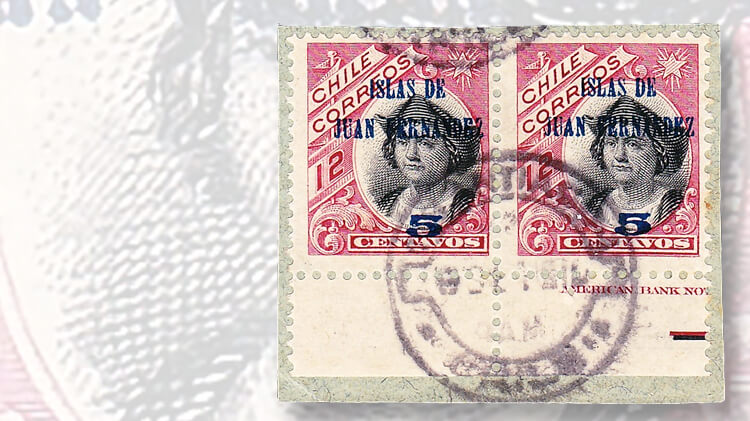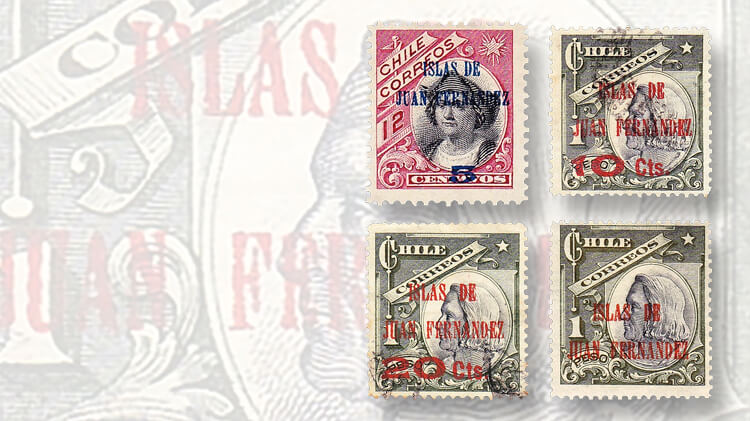World Stamps
Islas de Juan Fernandez 1910 overprints are collectible curiosities of Chile
Stamps of Latin America — By Thomas P. Myers
In 1910, a group of speculators conspired with postal officials to overprint a series of stamps exclusively for use on the sparsely inhabited Juan Fernandez Islands, located 416 miles off the coast of Chile.
The three islands in the group have a combined land mass of less than 39 square miles.
Once the trick was discovered, the Chilean government was forced to make the stamps available and valid throughout the country.
Connect with Linn’s Stamp News:
Sign up for our newsletter
Like us on Facebook
Follow us on Twitter
In fact, they were fairly widely used. I have recorded covers from Santiago, Valparaiso, and Vina del Mar; I am still looking for one mailed from the Islas Juan Fernandez.
The islands were discovered Nov. 22, 1574, by the Spanish sailor Juan Fernandez on a voyage south from Callao, Peru, to Valparaiso, Chile. He sailed so far from the coast to avoid the powerful Humboldt Current, which sweeps northward along the coast.
The Humboldt Current is the mother of the recurring series of climatic changes known as El Nino, which sometimes causes weather problems in the Northern Hemisphere.
Later, the islands served as a pirate hideout, and also where Scottish sailor Alexander Selkirk was marooned from 1704 to 1709, becoming the inspiration for Daniel Defoe’s novel Robinson Crusoe.
The basic stamps, issued 1905-09 (Scott 73 and 78), have designs portraying Christopher Columbus and were printed by the American Banknote Co.
The overprints were of two kinds: One included a denomination surcharge (5 centavos, 10c, or 20c) plus the words “ISLAS DE JUAN FERNANDEZ,” and the other had only the Islas name. The overprints were added by La Imprenta Universo de Valparaiso.
The overprinted issues are a 5c surcharge plus Islas name on the 12c (Chile Scott 79), a 10c surcharge plus Islas name on the 1 peso (80), a 20c surcharge plus Islas name on the 1p (81), and only the Islas name overprinted on the 1p (82).
As far as the quantities issued are concerned, 1.5 million of the 5c stamps were overprinted in dark or clear blue, 400,000 of the 10c and 20c were overprinted in red, and 200,000 of the 1p were overprinted in red.
The stamps were issued in August 1910, and the remainders were incinerated Nov. 11, 1911.
The number of incinerated lower denominations is not known, but 146,785 of the overprinted 1p stamps were destroyed — more than three-quarters of the printing. Used examples of the lower denominations are not difficult to find.
There are two important varieties of the overprint on the 5c-on-12c stamp. In one case, an Arabic “2” was substituted for the “Z” in “FERNANDEZ,” as shown on the stamp at left in the second illustration. This variety occurs on stamp number 94 (the fourth stamp in the 10th row) on a sheet.
Elsewhere on the sheet there is a similar error with a “7” substituted for the “Z.” I do not know its position.
The beauty of the item in the second picture lies not only in the fact that it has the “2” error, is on piece, and is postmarked in Santiago, but also that it preserves the sheet margin with the partial imprint of the American Bank Note Co. and the black and red registration lines beneath. I was very happy to add it to my collection.
MORE RELATED ARTICLES
Headlines
-
US Stamps
Oct 7, 2024, 3 PMMcMurtrie dismissed as APS education director following Sept. 21 arrest
-
US Stamps
Oct 7, 2024, 12 PMVasiliauskas named president of Mystic Stamp Co.
-
US Stamps
Oct 6, 2024, 5 PMApgar souvenir card available
-
US Stamps
Oct 6, 2024, 4 PMFirst Continental Congress and U.N. stamps receive Scott catalog numbers










